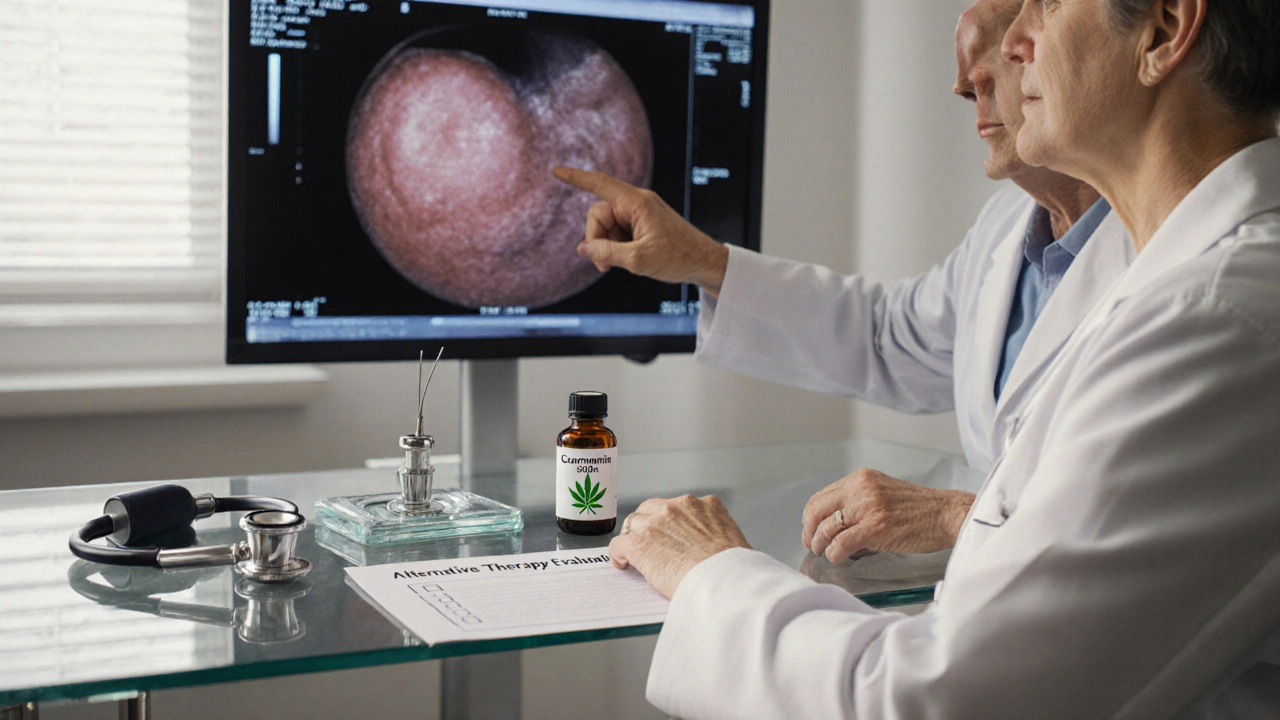Melanoma Therapy Comparison Tool
This tool compares conventional and alternative melanoma therapies based on evidence levels, primary goals, typical usage, and key safety concerns.
Conventional Treatments
- Surgery High Evidence
- Immunotherapy High Evidence
- Targeted Therapy High Evidence
- Radiation High Evidence
Alternative Therapies
- Acupuncture Low-Moderate Evidence
- Turmeric/Curcumin Very Low Evidence
- Medical Cannabis Low-Moderate Evidence
- Mind-Body Practices Low-Moderate Evidence
Detailed Comparison
| Therapy | Primary Goal | Evidence Level | Typical Use | Key Safety Concerns |
|---|---|---|---|---|
| Surgery | Remove tumor | High (Phase III trials) | Curative for stages I-II | Infection, scarring |
| Immunotherapy (PD-1 inhibitors) | Stimulate immune response | High (large RCTs) | Advanced disease | Autoimmune colitis, hepatitis |
| Acupuncture | Symptom relief (pain, fatigue) | Low-moderate (small RCTs) | Adjunct during treatment | Infection if needles not sterile |
| Turmeric/Curcumin supplement | Anti-inflammatory, possible anti-tumor | Very low (pre-clinical, few human trials) | Oral supplement | Bleeding risk, drug interactions |
| Medical Cannabis (CBD-dominant) | Pain, nausea, sleep | Low-moderate (observational) | Oral or inhaled forms | THC-related psychosis, immunomodulation |
| Mind-Body (Yoga, Meditation) | Stress reduction, QoL | Low-moderate (meta-analyses) | Regular practice, 2-3 times/week | Minimal; avoid extreme poses if bone mets present |
Important Note
While alternative therapies can help manage symptoms and improve quality of life, they do not replace proven conventional treatments for melanoma. Always consult with your oncology team before starting any new therapy.
Facing a melanoma diagnosis forces patients to juggle a maze of treatment options, side‑effects, and lifestyle changes. While surgery, immunotherapy, and targeted drugs dominate the clinical conversation, many people also explore alternative medicine melanoma approaches hoping to boost outcomes or ease discomfort. This article breaks down what alternative therapies actually are, how they interact with standard melanoma care, and what real‑world evidence says about safety and effectiveness.
Key Takeaways
- Conventional melanoma treatments (surgery, immunotherapy, targeted therapy) have the strongest survival data.
- Alternative therapies such as acupuncture, specific herbal supplements, and medical cannabis can help manage symptoms but lack robust survival evidence.
- Safety hinges on product quality, dosage, and open communication with your oncology team.
- Integrative oncology-coordinating conventional and complementary care-offers a structured way to try alternative options responsibly.
- Use the provided checklist to evaluate any new therapy before adding it to your regimen.
Understanding Melanoma
Melanoma is a malignant tumor arising from melanocytes, the pigment‑producing cells in the skin. According to the World Health Organization, more than 320,000 new cases are diagnosed worldwide each year, and its mortality rate spikes once the cancer spreads beyond the skin.
Melanoma is a fast‑growing skin cancer that can metastasize to organs such as the lungs, liver, brain and bones. Early‑stage disease (stage I‑II) is usually curable with surgery, while advanced stages (III‑IV) require systemic therapies.
Conventional Treatment Overview
Standard care follows a stepwise protocol:
- Surgery - excision of the primary tumor with clear margins.
- Immunotherapy - checkpoint inhibitors like pembrolizumab or nivolumab that unleash the immune system.
- Targeted therapy - BRAF and MEK inhibitors for tumors with specific gene mutations.
- Radiation - used for brain or bone metastases.
- Adjuvant therapy - additional treatment after surgery to reduce recurrence risk.
These modalities have been validated in large phase‑III trials, translating into five‑year survival rates above 80% for early disease and 30‑40% for stageIV.

What Is Alternative Medicine?
Alternative Medicine is a collection of health practices not traditionally part of mainstream Western medicine. When used alongside conventional care, it becomes "complementary" rather than truly alternative, a distinction emphasized by the field of integrative oncology.
Common categories include mind‑body techniques, natural products (herbs, vitamins), energy therapies, and physical modalities such as acupuncture.
Common Alternative Modalities Used in Melanoma
Acupuncture
Acupuncture is a needle‑based therapy rooted in Traditional Chinese Medicine that aims to balance the body’s energy pathways. Oncology patients often turn to acupuncture for nausea, pain, and fatigue.
Small RCTs (e.g., a 2022 study of 80 melanoma patients on immunotherapy) showed a 30% reduction in treatment‑related fatigue, though there’s no direct impact on tumor size.
Herbal Supplements
Herbs such as turmeric (curcumin) - a polyphenol with anti‑inflammatory properties and green tea extract are popular for their antioxidant claims.
Laboratory work indicates curcumin can inhibit melanoma cell proliferation, but human trials are limited and dosage varies widely. Interaction with chemotherapy (e.g., increased bleeding risk) is a real concern.
Medical Cannabis
Medical Cannabis is a plant‑derived product containing THC and CBD used for pain, appetite loss, and nausea. In a 2023 Australian cohort of 112 melanoma patients, 68% reported better sleep and reduced opioid use after starting a CBD‑dominant formulation.
Regulatory status in Australia means patients must obtain a prescription through a specialist, and THC can interfere with certain immune checkpoint drugs.
Mind‑Body Therapies
Yoga, meditation, and guided imagery are shown to lower cortisol levels and improve quality‑of‑life scores. A 2021 meta‑analysis of 15 oncology trials found a 25% drop in reported anxiety among participants practicing mindfulness at least three times per week.
Vitamins & Antioxidants
VitaminD deficiency is common in melanoma patients, especially those who avoid sun exposure after diagnosis. Observational studies link higher serum vitaminD levels with modestly better progression‑free survival, but supplementation should be guided by blood tests.
Evidence & Safety - What the Data Actually Say
Across all alternative modalities, the evidence hierarchy looks like this:
- High‑quality RCTs - scarce; most studies are small, open‑label, or pre‑clinical.
- Observational data - useful for safety signals but prone to bias.
- Anecdotal reports - plentiful online but not reliable for clinical decisions.
Key safety takeaways:
- Herbal products can be contaminated with heavy metals or undisclosed pharmaceuticals.
- Acupuncture is low‑risk when performed by licensed practitioners, but improper needle placement can cause infection.
- Cannabis may interact with immunotherapy by modulating cytokine pathways; dose titration is essential.
- VitaminD excess can lead to hypercalcemia, especially in patients with kidney involvement.
Integrating Alternative Therapies with Conventional Care
Integrative oncology programs-found in major cancer centers in Melbourne, Sydney, and overseas-provide a structured framework:
- Disclosure - Always tell your oncologist about any supplement, herbal product, or mind‑body practice you’re considering.
- Timing - Schedule therapies that won’t clash with chemo infusion sites (e.g., acupuncture after, not during, infusion).
- Monitoring - Track side‑effects, blood work, and tumor markers before and after starting a new modality.
- Evidence Review - Use reputable sources such as NCCN Guidelines, Cochrane Reviews, or peer‑reviewed oncology journals.
When doctors and complementary practitioners cooperate, patients report higher satisfaction and better adherence to the primary treatment plan.

Decision Checklist for Patients
- Is the therapy supported by at least one peer‑reviewed study?
- Has the product been third‑party tested for purity?
- Will it interact with my current medication (e.g., immunotherapy, anticoagulants)?
- Do I have a qualified practitioner (licensed acupuncturist, certified yoga instructor)?
- Have I discussed it with my oncology team and documented it in my medical record?
- Can I realistically maintain the regimen alongside my primary treatment schedule?
Comparison of Popular Alternative Modalities vs Conventional Options
| Therapy | Primary Goal | Evidence Level | Typical Use | Key Safety Concerns |
|---|---|---|---|---|
| Surgery | Remove tumor | High (PhaseIII trials) | Curative for stagesI‑II | Infection, scarring |
| Immunotherapy (PD‑1 inhibitors) | Stimulate immune response | High (large RCTs) | Advanced disease | Autoimmune colitis, hepatitis |
| Acupuncture | Symptom relief (pain, fatigue) | Low‑moderate (small RCTs) | Adjunct during treatment | Infection if needles not sterile |
| Turmeric/Curcumin supplement | Anti‑inflammatory, possible anti‑tumor | Very low (pre‑clinical, few human trials) | Oral supplement | Bleeding risk, drug interactions |
| Medical Cannabis (CBD‑dominant) | Pain, nausea, sleep | Low‑moderate (observational) | Oral or inhaled forms | THC‑related psychosis, immunomodulation |
| Mind‑Body (Yoga, Meditation) | Stress reduction, QoL | Low‑moderate (meta‑analyses) | Regular practice, 2‑3times/week | Minimal; avoid extreme poses if bone mets present |
Next Steps & Resources
If you’re considering an alternative approach, start with these actions:
- Schedule a dedicated appointment with your oncologist to discuss any supplement or therapy you’ve heard about.
- Locate a reputable integrative oncology clinic-major Australian public hospitals now host such services.
- Request third‑party testing certificates for any herbal product.
- Keep a symptom diary (pain score, sleep quality, side‑effects) before and after starting the new therapy.
- Review up‑to‑date guidelines from the National Comprehensive Cancer Network (NCCN) or Cancer Australia.
Remember, the safest path combines proven cancer‑killing treatments with evidence‑backed supportive care, not untested miracles.
Frequently Asked Questions
Can acupuncture cure melanoma?
No. Acupuncture does not target cancer cells. It can, however, help manage side‑effects like fatigue, nausea, or localized pain when used alongside standard treatment.
Is it safe to take turmeric supplements while on immunotherapy?
Turmeric can thin the blood and may amplify immune‑related adverse events. Always check dosage with your oncologist and prefer a pharmaceutical‑grade extract that has been tested for contaminants.
Does medical cannabis improve survival in melanoma?
Current research shows cannabis helps with symptom control but does not demonstrably extend overall survival. Use it under a specialist’s prescription for pain or appetite issues.
What is integrative oncology?
Integrative oncology blends evidence‑based conventional cancer treatment with complementary therapies that improve quality of life, all under coordinated medical supervision.
Should I stop all supplements during chemotherapy?
Not necessarily, but many supplements can interfere with drug metabolism. Discuss each product; some, like high‑dose vitaminC, are best paused during active chemo cycles.


HAMZA JAAN
October 9, 2025 AT 17:10Honestly, I've seen way too many patients gamble on the hype of "miracle herbs" while ignoring the rock‑solid data behind surgery and immunotherapy. It's a classic case of chasing a glittery shortcut instead of sticking to what actually saves lives. If you think a few needles or a turmeric capsule can replace a PD‑1 inhibitor, you're setting yourself up for disappointment. Think twice before you let anecdotal blogs dictate your treatment plan.
April Rios
October 18, 2025 AT 18:06When we stare at the sprawling table of alternatives-acupuncture, curcumin, cannabis, yoga-it feels like confronting a philosophical paradox: the yearning for holistic harmony versus the ruthless clarity of evidence. The first point to acknowledge is that "evidence" is a spectrum, not a binary switch; a low‑moderate rating still means there have been some controlled attempts, however limited. Yet, the seductive allure of these practices often stems from their promise to "heal the whole person," a concept the reductionist model of oncology tends to sideline.
We must ask ourselves whether the primary goal is to extend survival or to enrich the lived experience within the inevitable constraints of disease. If the latter, then symptom‑relief interventions such as acupuncture for fatigue or yoga for stress reduction can be justified, provided they are not misconstrued as curative.
Conversely, supplementing with turmeric while on checkpoint inhibitors demands a nuanced risk assessment: curcumin can interfere with platelet function and possibly amplify immune‑related adverse events. The same caution applies to cannabis, where THC may modulate cytokine pathways and unintentionally dampen the immune response that immunotherapy relies upon.
Integration, therefore, becomes a dance of timing, dosage, and transparent communication. Scheduling acupuncture sessions after infusion, not during, minimizes the risk of compromised sterility at the catheter site. Obtaining third‑party testing certificates for any herbal product shields against contamination and hidden pharmacology.
Ultimately, the ethical backbone of integrative oncology rests on informed consent. Disclose every supplement and practice to your oncologist, document it meticulously, and monitor both biomarkers and subjective well‑being. In this way, we honor both the scientific rigor that has transformed melanoma survival rates and the human desire for agency over one's body.
byron thierry
October 28, 2025 AT 00:20Dear colleagues, it is pertinent to underscore that the historical evolution of melanoma management has been propelled by methodical clinical trials, which furnish us with high‑grade evidence. While complementary modalities possess cultural resonance and may ameliorate ancillary symptoms, they should be positioned as adjuncts rather than substitutes. I would advocate for a structured framework wherein any alternative therapy is first evaluated for pharmacodynamic interactions with standard regimens. Moreover, the practitioner delivering such therapies ought to possess verifiable credentials, ensuring sterility and patient safety. In sum, a balanced, evidence‑guided approach remains the cornerstone of optimal patient outcomes.
bob zika
October 28, 2025 AT 03:06Indeed, your observations are most astute, Dr. Byron; the emphasis on credential verification, as you rightly point out, is indispensable, particularly when integrating modalities such as acupuncture, which, albeit low‑risk, can pose infection hazards if aseptic technique lapses. Furthermore, the suggestion of a systematic pharmacodynamic review aligns perfectly with best‑practice guidelines, ensuring that no inadvertent antagonism compromises immunotherapy efficacy. Thank you for articulating these considerations so clearly.
M Black
November 6, 2025 AT 06:33Love the vibe 😊
Sidney Wachira
November 6, 2025 AT 09:20Whoa, hold up! If you think a few yoga poses are going to slay melanoma, you’re living in a fantasy novel. I’ve read the studies-nothing more than minor stress relief, not a miracle cure. The drama around “natural cures” is getting out of hand; it distracts from the life‑saving power of checkpoint inhibitors. Sure, CBD might ease nausea, but over‑indulging can mess with your immune response. And don’t get me started on turmeric; the hype is bigger than the data, and the bleeding risk is real! Patients need to stop googling miracle cures and start listening to their oncologists. The only drama we need is in the clinic, not in the supplement aisle. 🌟
Aditya Satria
November 15, 2025 AT 12:46Team, let’s keep the conversation grounded in clear, actionable steps. Start by asking patients for a complete list of supplements; that’s the first line of defense against hidden drug interactions. Next, recommend only third‑party tested products and avoid high‑dose herbal extracts without solid data. Encourage them to maintain a symptom diary-pain scores, sleep quality, nausea levels-so we can objectively assess any benefit. This systematic approach respects both patient autonomy and clinical safety.
Jocelyn Hansen
November 15, 2025 AT 15:33Great points, Aditya! 👍 Keeping a symptom diary is such a practical tool; it bridges the gap between subjective experience and measurable outcomes. Also, reminding patients to bring their supplement list to every appointment can prevent hidden interactions. Thanks for the clear action items!
Joanne Myers
November 24, 2025 AT 19:00In formal terms, adherence to evidence‑based protocols remains paramount.
rahul s
November 24, 2025 AT 21:46Listen up, friends! If you’re still buying “miracle” herbs from some random market, you’re basically feeding the snake you claim to fear. Real science doesn’t need fireworks; it needs rigor, not your colorful fantasies. Stick to what works, or you’ll just be another statistic in the “alternative” tragedy.